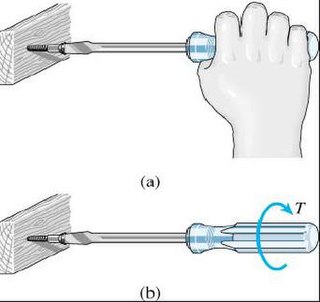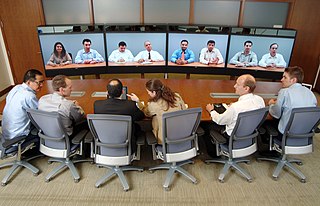Related Research Articles

An intranet is a computer network for sharing information, easier communication, collaboration tools, operational systems, and other computing services within an organization, usually to the exclusion of access by outsiders. The term is used in contrast to public networks, such as the Internet, but uses the same technology based on the Internet protocol suite.
Human relations movement refers to the researchers of organizational development who study the behaviour of people in groups, particularly in workplace groups and other related concepts in fields such as industrial and organizational psychology. It originated in the 1930s' Hawthorne studies, which examined the effects of social relations, motivation and employee satisfaction on factory productivity. The movement viewed workers in terms of their psychology and fit with companies, rather than as interchangeable parts, and it resulted in the creation of the discipline of human relations management.

Usability can be described as the capacity of a system to provide a condition for its users to perform the tasks safely, effectively, and efficiently while enjoying the experience. In software engineering, usability is the degree to which a software can be used by specified consumers to achieve quantified objectives with effectiveness, efficiency, and satisfaction in a quantified context of use.
The Toyota Production System (TPS) is an integrated socio-technical system, developed by Toyota, that comprises its management philosophy and practices. The TPS is a management system that organizes manufacturing and logistics for the automobile manufacturer, including interaction with suppliers and customers. The system is a major precursor of the more generic "lean manufacturing". Taiichi Ohno and Eiji Toyoda, Japanese industrial engineers, developed the system between 1948 and 1975.

Organizational theory refers to a series of interrelated concepts that involve the sociological study of the structures and operations of formal social organizations. Organizational theory also seeks to explain how interrelated units of organization either connect or do not connect with each other. Organizational theory also concerns understanding how groups of individuals behave, which may differ from the behavior of an individual. The behavior organizational theory often focuses on is goal-directed. Organizational theory covers both intra-organizational and inter-organizational fields of study.

A collaboration tool helps people to collaborate. The purpose of a collaboration tool is to support a group of two or more individuals to accomplish a common goal or objective. Collaboration tools can be either of a non-technological nature such as paper, flipcharts, post-it notes or whiteboards. They can also include software tools and applications such as collaborative software.

Business process re-engineering (BPR) is a business management strategy originally pioneered in the early 1990s, focusing on the analysis and design of workflows and business processes within an organization. BPR aims to help organizations fundamentally rethink how they do their work in order to improve customer service, cut operational costs, and become world-class competitors.

5S is a workplace organization method that uses a list of five Japanese words: seiri (整理), seiton (整頓), seisō (清掃), seiketsu (清潔), and shitsuke (躾). These have been translated as 'sort', 'set in order', 'shine', 'standardize', and 'sustain'. The list describes how to organize a work space for efficiency and effectiveness by identifying and storing the items used, maintaining the area and items, and sustaining the new organizational system. The decision-making process usually comes from a dialogue about standardization, which builds understanding among employees of how they should do the work.
Participatory management is the practice of empowering members of a group, such as employees of a company or citizens of a community, to participate in organizational decision making. It is used as an alternative to traditional vertical management structures, which has shown to be less effective as participants are growing less interested in their leader's expectations due to a lack of recognition of the participant's effort or opinion.
Management consists of the planning, prioritizing, and organizing work efforts to accomplish objectives within a business organization. A management style is the particular way managers go about accomplishing these objectives. It encompasses the way they make decisions, how they plan and organize work, and how they exercise authority.

In business computer information systems, a dashboard is a type of graphical user interface which often provides at-a-glance views of key performance indicators (KPIs) relevant to a particular objective or business process. In other usage, "dashboard" is another name for "progress report" or "report" and considered a form of data visualization. In providing this overview, business owners can save time and improve their decision making by utilizing dashboards.

Workforce productivity is the amount of goods and services that a group of workers produce in a given amount of time. It is one of several types of productivity that economists measure. Workforce productivity, often referred to as labor productivity, is a measure for an organisation or company, a process, an industry, or a country.
Employee scheduling software automates the process of creating and maintaining a schedule. Automating the scheduling of employees increases productivity and allows organizations with hourly workforces to re-allocate resources to non-scheduling activities. Such software will usually track vacation time, sick time, compensation time, and alert when there are conflicts. As scheduling data is accumulated over time, it may be extracted for payroll or to analyze past activity. Although employee scheduling software may or may not make optimization decisions, it does manage and coordinate the tasks. Today's employee scheduling software often includes mobile applications. Mobile scheduling further increased scheduling productivity and eliminated inefficient scheduling steps. It may also include functionality including applicant tracking and on-boarding, time and attendance, and automatic limits on overtime. Such functionality can help organizations with issues like employee retention, compliance with labor laws, and other workforce management challenges.

Visual merchandising is the practice in the retail industry of optimizing the presentation of products and services to better highlight their features and benefits. The purpose of such visual merchandising is to attract, engage, and motivate the customer towards making a purchase.
Control is a function of management that helps to check errors and take corrective actions. This is done to minimize deviation from standards and ensure that the stated goals of the organization are achieved in a desired manner.
Organizational conflict, or workplace conflict, is a state of discord caused by the actual or perceived opposition of needs, values and interests between people working together. Conflict takes many forms in organizations. There is the inevitable clash between formal authority and power and those individuals and groups affected. There are disputes over how revenues should be divided, how the work should be done, and how long and hard people should work. There are jurisdictional disagreements among individuals, departments, and between unions and management. There are subtler forms of conflict involving rivalries, jealousies, personality clashes, role definitions, and struggles for power and favor. There is also conflict within individuals – between competing needs and demands – to which individuals respond in different ways.
A distributed workforce is a workforce that conducts remote work. A distributed workforce is dispersed geographically over a wide area – domestically or internationally. Via technology, distributed companies enable employees located anywhere to access all of the company's resources and software such as applications, data and e-mail without working within the confines of an office.
Participative decision-making (PDM) is the extent to which employers allow or encourage employees to share or participate in organizational decision-making. According to Cotton et al., the format of PDM could be formal or informal. In addition, the degree of participation could range from zero to 100% in different participative management (PM) stages.
Obeya originated from a long history of learning & improving. The earliest notion of which is believed to be the Analects of Confucius nearly 2500 years ago. The roots of what is now a valuable management practice can be found across continents with many disciplines influencing each other throughout history. One of the more recognizable modern examples involving Obeya was at Toyota during the G21 Project, while building the Prius. Chief Engineer of the G21 project, Takeshi Uchiyamada “felt that he lacked the necessary authority to make the optimal decisions and thought he could be overrun by experienced discipline leaders in a way that was not optimal for the project as such”. This need for support from the other leaders that Uchiyamada identified, is what manifested for him the first use of Obeya "large room" in this environment. The Obeya, was instituted "as an arena for all his discussions with the discipline leaders. In this room, the other discipline leaders would be present, and documents and data would be available to all."
The visual workplace is a continuous improvement paradigm that is closely related to lean manufacturing, the Toyota Production System (TPS), and operational excellence yet offers its own comprehensive methodology that aims for significant financial and cultural improvement gains. Introduced by Gwendolyn Galsworth in her 1997 book Visual Systems, this system integrates and codifies the many iterations of visuality in the world of continuous improvement.
References
- ↑ Lindlof, Ludvig; Soderberg, Bjorn (2011). "Pros and cons of lean visual planning: experiences from four product development organisations". International Journal of Technology Intelligence and Planning. 7 (3): 269–279. doi:10.1504/IJTIP.2011.044614.
- ↑ Bateman, Nicola; Philp, Lee; Warrender, Harry (2016). "Visual management and shop floor teams–development, implementation and use". International Journal of Production Research. 54 (24): 7345–7358. doi:10.1080/00207543.2016.1184349. hdl: 2381/43809 .
- ↑ Greif, Michel (1991). The visual factory : building participation through shared information. Cambridge, Mass.: Productivity Press. ISBN 0915299674. OCLC 22488262.